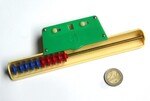
De Kleine Rekenmeester is a toy consisting of a rod with 10 beads, and a simple counter that keeps track of how many beads have moved from left to right. This allows a child to become familiar with the digits and do small sums. There is a sliding shutter that can hide the counter, so that the child can try to predict what the end result is and then open the shutter to check if they were right.
It comes in a cardboard box, and the lid bears the texts "Hoeveelheid en Getal" (Amount and Number), "De Kleine Rekenmeester" (The Little Accountant), and the name of the producer "J.B. Wolters - Groningen Djakarta". This
The mechanism is very simple. There is a small 5-toothed gear that has one tooth that is in the path of the beads. When a bead is moved acorss, it rotates the gear by one tooth. That small gear drives a larger gear which acts as the number wheel. When the small gear moves by one tooth, the large number wheel rotates one step so that the number visible in the window is incremented or decremented. There is an alignment mechanism consisting of a spring that pushes a round metal disc against the number wheel.
I do not have the instruction booklet, but there are pictures online from which I extracted the text. The Dutch text below is followed by an English translation.
TELRAAM MET ZELFCONTROLE TOELICHTING Bij het voorbereidende rekenen is het van zeer groot belang, dat de leerlingen beschikken over een aantal aantrekkelijke hulp- en leermiddelen. Bij dit "rekenen" zal het kind n.l. ontdekkingen moeten doen! Door hoeveelheden te groeperen en te ordenen, te tellen en te herkennen, door ze bij elkaar op te tellen en van elkaar af te nemen ontdekt het kind "het rijk der getallen". Juist de verscheidenheid van de leermiddelen, juist het afwisselende in zijn rekenmateriaal zal het kind prikkelen tot verdergaan op zijn ontdekkingsreis. Bovendien kan men in de aanvangsklas vooral bij het vak
rekenen constateren, dat er bij de leerlingen een groot
verschil bestaat in aanleg, rijpheid en tempo.
Het kind zal dan naar een opdracht of geheel vrij zelf zijn
sommen bedenken.
De Kleine Rekenmeester is voor bovengenoemde doeleinden zeer geschikt.
Gebruik:
Tellen en verbinden van hoeveelheid en cijfer.
Optellen en aftrekken.
Sommetjes.
Samenwerken.
Den Haag.
M. Gerretsen
Onderwijzeres. |
ABACUS WITH SELF-CHECK EXPLANATION It is very important for preparatory arithmetic that the pupils have access to a number of attractive aids and learning resources. With this "calculation" the child will actually have to make discoveries! By grouping and ordering quantities, counting and recognizing, adding and subtracting them, the child discovers "the realm of numbers". It is precisely the diversity of the teaching aids, precisely the variety in its calculation material, that will stimulate the child to continue on its journey of discovery. Moreover, in the first class, especially in the subject of arithmetic, it can be observed that there is a great difference among the students in aptitude, maturity and pace.
The child will then come up with his own sums after an assignment or completely freely.
The Little Accountant is very suitable for the above purposes.
This modern abacus is so ingeniously arranged that when the discs are moved, each disc passes a wheel, causing a number to jump.
Usage:
Counting and Connecting Quantity and Digit.
Addition and subtraction.
Sums.
To collaborate.
The Hague.
M. Gerretsen
School teacher. |
J.B. Wolters was a publisher of schoolbooks and other educational materials. It was founded by Jan Berends Wolters in 1836 in Groningen. Its best known publication was De Grote Bosatlas, an educational world atlas first printed in 1877, which had its 55 edition published in 2018. They opened offices in other locations, including Den Haag (1915), Batavia/Djakarta/Jakarta (1923), and Leuven in Belgium (1958). Note that they only printed Djakarta on their books in the period 1950-1955, which gives a date to De Kleine Rekenmeester. The company merged with P. Noordoff in 1968 to form Wolters-Noordhoff.
Dux was a brand name of Markes & Co. This company was founded by Carl Markes in 1904 in Lüdenscheid, Germany, and at first made cutting and printing tools. Soon they started making bearings and other metal machinery parts, but in 1916 they also started making metal toys, such as metal building sets similar to Meccano and model cars. In 1950 they began injection molding plastic, leading to the manufacturing of plastic toys such as De Kleine Rekenmeester. Their most popular toy was the Dux Kino, a toy film projector. Toy production ended in the 1980s. The company still exists today, but they have specialised in producing bearings and conveyor technology.
© Copyright 2023 Jaap Scherphuis, mechcalc a t jaapsch d o t net.